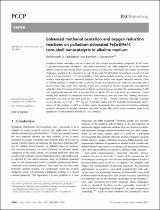 ResearchSpace
ResearchSpace
Enhanced methanol oxidation and oxygen reduction reactions on palladium-decorated FeCo@Fe/C core–shell nanocatalysts in alkaline medium
JavaScript is disabled for your browser. Some features of this site may not work without it.
- ResearchSpace
- →
- Research Publications/Outputs
- →
- Journal Articles
- →
- View Item
| dc.contributor.author |
Fashedemi, OO

|
|
| dc.contributor.author |
Ozoemena, KI

|
|
| dc.date.accessioned | 2014-05-22T11:48:18Z | |
| dc.date.available | 2014-05-22T11:48:18Z | |
| dc.date.issued | 2013-12 | |
| dc.identifier.citation | Fashedemi, O.O and Ozoemena, K.I. 2013. Enhanced methanol oxidation and oxygen reduction reactions on palladium-decorated FeCo@Fe/C core–shell nanocatalysts in alkaline medium. Physical Chemistry Chemical Physics, vol. 15(48), pp 20982-20991 | en_US |
| dc.identifier.issn | 1463-9076 | |
| dc.identifier.uri | http://pubs.rsc.org/en/content/articlelanding/2013/cp/c3cp52601a/unauth#!divAbstract | |
| dc.identifier.uri | http://hdl.handle.net/10204/7428 | |
| dc.description | Copyright: 2013 Royal Society of Chemistry. This is an OA journal. The journal authorizes the publication of the information herewith contained. | en_US |
| dc.description.abstract | Palladium based nano-alloys are well known for their unique electrocatalytic properties. In this work, a palladium-decorated FeCo@Fe/C core-shell nanocatalyst has been prepared by a new method called microwave-induced top-down nanostructuring and decoration (MITNAD). This simple, yet efficient technique, resulted in the generation of sub-10 nm sized FeCo@Fe@Pd nanocatalysts (mainly 3-5 nm) from a micron-sized (0.21-1.5 µm) FeCo@Fe/C. The electrocatalytic activities of the core-shell nanocatalysts were explored for methanol oxidation reaction (MOR) and oxygen reduction reaction (ORR) in alkaline medium. A negative shift of 300 mV in the onset potential for MOR was observed, with a current thrice that of the Pd/C catalysts. A very low resistance to electron transfer (Rct) was observed while the ratio of forward-to-backward oxidation current (If/Ib) was doubled. The overpotential of ORR was significantly reduced with a positive shift of about 250 mV and twice the reduction current density was observed in comparison with Pd/C nanocatalysts with the same mass loading. The kinetic parameters (in terms of the Tafel slope (b) = -59.7 mV dec(-1) (Temkin isotherm) and high exchange current density (jo) = 1.26 × 10(-2) mA cm(-2)) provide insights into the favorable electrocatalytic performance of the catalysts in ORR in alkaline media. Importantly, the core-shell nanocatalyst exhibited excellent resistance to possible methanol cross-over during ORR, which shows excellent promise for application in direct alkaline alcohol fuel cells (DAAFCs). | en_US |
| dc.language.iso | en | en_US |
| dc.publisher | Royal Society of Chemistry | en_US |
| dc.relation.ispartofseries | Workflow;12577 | |
| dc.subject | Nano-alloys | en_US |
| dc.subject | Electrocatalytic properties | en_US |
| dc.subject | Palladium (Pd)-based electrocatalysts | en_US |
| dc.subject | Direct alkaline alcohol fuel cells | en_US |
| dc.subject | DAAFCs | en_US |
| dc.title | Enhanced methanol oxidation and oxygen reduction reactions on palladium-decorated FeCo@Fe/C core–shell nanocatalysts in alkaline medium | en_US |
| dc.type | Article | en_US |
| dc.identifier.apacitation | Fashedemi, O., & Ozoemena, K. (2013). Enhanced methanol oxidation and oxygen reduction reactions on palladium-decorated FeCo@Fe/C core–shell nanocatalysts in alkaline medium. http://hdl.handle.net/10204/7428 | en_ZA |
| dc.identifier.chicagocitation | Fashedemi, OO, and KI Ozoemena "Enhanced methanol oxidation and oxygen reduction reactions on palladium-decorated FeCo@Fe/C core–shell nanocatalysts in alkaline medium." (2013) http://hdl.handle.net/10204/7428 | en_ZA |
| dc.identifier.vancouvercitation | Fashedemi O, Ozoemena K. Enhanced methanol oxidation and oxygen reduction reactions on palladium-decorated FeCo@Fe/C core–shell nanocatalysts in alkaline medium. 2013; http://hdl.handle.net/10204/7428. | en_ZA |
| dc.identifier.ris | TY - Article AU - Fashedemi, OO AU - Ozoemena, KI AB - Palladium based nano-alloys are well known for their unique electrocatalytic properties. In this work, a palladium-decorated FeCo@Fe/C core-shell nanocatalyst has been prepared by a new method called microwave-induced top-down nanostructuring and decoration (MITNAD). This simple, yet efficient technique, resulted in the generation of sub-10 nm sized FeCo@Fe@Pd nanocatalysts (mainly 3-5 nm) from a micron-sized (0.21-1.5 µm) FeCo@Fe/C. The electrocatalytic activities of the core-shell nanocatalysts were explored for methanol oxidation reaction (MOR) and oxygen reduction reaction (ORR) in alkaline medium. A negative shift of 300 mV in the onset potential for MOR was observed, with a current thrice that of the Pd/C catalysts. A very low resistance to electron transfer (Rct) was observed while the ratio of forward-to-backward oxidation current (If/Ib) was doubled. The overpotential of ORR was significantly reduced with a positive shift of about 250 mV and twice the reduction current density was observed in comparison with Pd/C nanocatalysts with the same mass loading. The kinetic parameters (in terms of the Tafel slope (b) = -59.7 mV dec(-1) (Temkin isotherm) and high exchange current density (jo) = 1.26 × 10(-2) mA cm(-2)) provide insights into the favorable electrocatalytic performance of the catalysts in ORR in alkaline media. Importantly, the core-shell nanocatalyst exhibited excellent resistance to possible methanol cross-over during ORR, which shows excellent promise for application in direct alkaline alcohol fuel cells (DAAFCs). DA - 2013-12 DB - ResearchSpace DP - CSIR KW - Nano-alloys KW - Electrocatalytic properties KW - Palladium (Pd)-based electrocatalysts KW - Direct alkaline alcohol fuel cells KW - DAAFCs LK - https://researchspace.csir.co.za PY - 2013 SM - 1463-9076 T1 - Enhanced methanol oxidation and oxygen reduction reactions on palladium-decorated FeCo@Fe/C core–shell nanocatalysts in alkaline medium TI - Enhanced methanol oxidation and oxygen reduction reactions on palladium-decorated FeCo@Fe/C core–shell nanocatalysts in alkaline medium UR - http://hdl.handle.net/10204/7428 ER - | en_ZA |





